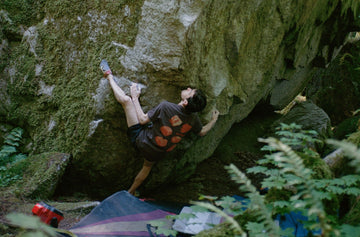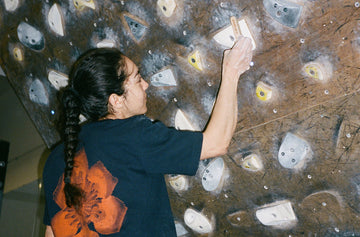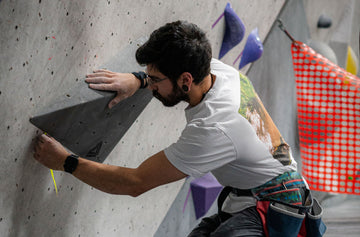I began climbing in winter 2013 when my friend, Victor, took me to Joe Rockhead’s in Toronto, Ontario. I enjoyed it so much that I climbed hard for 4 hours. My forearms were so sore afterwards I could barely open a door for days haha. Safe to say, after that, I was hooked! This was when I had begun studying kinesiology at the University of Waterloo and transitioning out of my amateur motocross and snowcross racing career. I had always enjoyed solo ‘extreme’ sports, so climbing felt like a very natural fit. Luckily, my university had converted one of the squash courts into a bouldering cave, and I hopped right into what turned out to be a major turning point in my life.
I grew up in Severn Bridge (Muskoka), ON, where I spent the majority of my spare time outside in nature doing various sports and activities. Now, I live in Squamish, BC, and do the same thing!

What specific skills or insights from your climbing experience have been most valuable in creating effective rehabilitation and coaching programs?
Effective rehabilitation or training often comes down to understanding a person - their motivations, beliefs, and passions. People need a concrete reason why they are (or are not) doing something in order to put in consistent effort.
Consistency cannot be overstated. I’ve seen this play a major role in the progression of my own climbing and certainly is something I help clients with. It is important that I paint a more clear picture of what I mean by consistency. This does not mean always sticking to a predetermined plan no matter what. In fact, the minutiae of day-to-day rehab or training is often secondary. What matters is putting in effort week-by-week, month-by-month, year-by-year. This is achieved through adaptability. Knowing when, how and being willing to modify their training, climbing, &/or rehab day-by-day to make it productive and sustainable over the long term.
How does shifting from an "all or nothing" mentality to a more "sustainable and productive" mindset affect climbers' approaches to injury recovery and long-term training goals?
Having an all-or-nothing approach (climbing until total physical and mental fatigue), on any given day isn’t necessarily a problem, and perhaps even a good way to challenge your perceived limits. But, there will be a price to pay. You gave it your all, now you’re left with nothing - it will take time for your body to fully recover and be back to full function. Depending on how depleted you were, this could take 3,4,5, 7+ days! So, in the end, you sacrifice a lot of good (well-rested) climbing sessions for this one all-or-nothing session. In addition, much of that all-or-nothing session was done in a physical and mental state in which you were unable to express your peak power and coordination, therefore diminishing the ability to make technical (skill) improvement. Basically, sacrificing more climbing in the moment, allows you much more high quality climbing in the future, leading to long-term progression.

When climbing gyms and rock climbing are not accessible, what are your top piece(s) of equipment for maintaining or improving climbing skills and strength?
If you have a period of time that you can’t climb and are looking to build off-the-wall strength for climbing, general pulling strength and finger strength are obvious places to start. A portable hangboard with a jug rung and an edge that is about a full-pad deep would do the trick.
Which protocol you do is somewhat arbitrary, and will depend on many factors like a person’s training history, goals, specific equipment available, and other factors that may impact recovery.
To build peak (max) strength, you want to be generating as much force as you can for a short period of time (<5s), rest for a relatively long amount of time (2+min), and repeat for generally 2-5 sets (again, depending on a variety of factors).
Some very simple examples that can be done anywhere and with minimal equipment are ground pulls (C4HP has called these recruitment pulls). This would be pulling on a bar or edge from overhead OR underneath - all with your feet still on the ground. These types of exercises are called overcoming isometrics, which involve pulling hard against an immovable object with no observable movement in the limbs. A strain gauge can make these exercises more tangible and measurable, although they are not absolutely necessary. You can simply pull to a perceived level of effort (e.g. 9/10, or 90% effort).
This example protocol can be done anywhere, has very low injury risk, and will stimulate pulling and finger strength gains for most climbers!:
~5 min of warm-up (e.g. bodyweight squats, submaximal edge pulls, pull-ups etc.).
5 sets of 5s overhead jug pull.
5 sets of 5s full-pad 4-finger edge lift/pull (edge anchored to foot or ground).
5 sets of 5s full-pad 3-finger Drag overhead edge pull.
-Full rest between all sets (1 min. or more)
-All exercise to 8-9/10 RPE
-2-3x/week if not concurrently climbing
Could you share what your resting days typically involve and how you ensure they are effective for recovery?
My resting days typically involve work, leisure, time with my partner and friends, and some mild outdoor exercise.
I eat similarly regardless of a rest day or not, meaning I stick to mostly non-processed foods and take in approximately a gram per pound of lean body weight in protein. On more active climbing days, I let my appetite guide an increased calorie intake. I definitely have days where I ‘stray’ from the path and eat processed foods. I just do my best to enjoy it in the moment and then nip in the bud before it becomes a regular habit.
For me, light exercise and time in nature are crucial for feeling healthy both physically and mentally. This is typically a walk around the neighbourhood or a jaunt in the forest - sometimes to scope some boulders if I am feeling particularly excited or curious about them! Often in the evening I’ll do some light stretching or very submaximal exercises.
Generally, the idea is to move my body, get the heart pumping & blood flowing, be in nature, provide my body with quality nutrition, and spend time with friends and loved ones.





